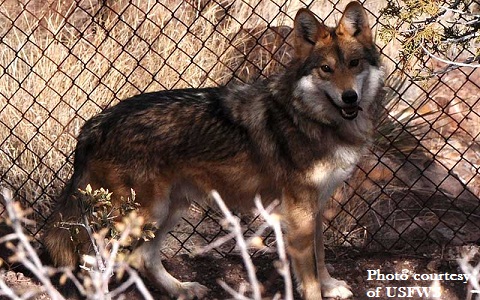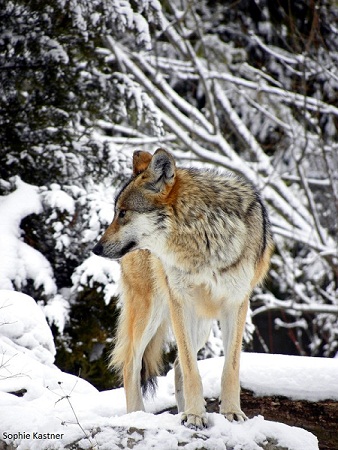In the News: Return of gray wolves to Southwest slow going
By Susan Montoya Bryan
 ALBUQUERQUE, N.M.—Mexican gray wolf No. 1105 was shot dead by wildlife managers after having a tryst—and puppies—with a common ranch dog. No. 1188, an alpha female, was almost executed, then taken away from her pups and pack, for killing cattle. And wolf No. 1133 was returned to captivity after failing to woo his intended mate.
ALBUQUERQUE, N.M.—Mexican gray wolf No. 1105 was shot dead by wildlife managers after having a tryst—and puppies—with a common ranch dog. No. 1188, an alpha female, was almost executed, then taken away from her pups and pack, for killing cattle. And wolf No. 1133 was returned to captivity after failing to woo his intended mate.
Fifteen years and more than $25 million after the federal government set about trying to return the endangered species to the American Southwest, the program drastically lags those credited with saving their cousins in the Northern Rockies, bald eagles and even the American crocodile.
The reason, critics say, federal wildlife managers are being too heavy-handed with the wild animals, picking and choosing which wolves get to mate, which get a spot at the front of the line for a chance at freedom and which need to be shot or rounded up and returned to captivity for indulging in cattle—easy prey in the rugged mountains of southern New Mexico and Arizona.
“They’re going by an old rubric, that there are good wolves and bad wolves,” said Michael Robinson of the Center for Biological Diversity, one of the groups critical of wolf management. “¦
Federal wildlife officials defend their handling of the program, saying one of the keys to wolf recovery is finding ways to reduce conflicts with people and livestock. The other is genetics. Without a diverse pool of genes, wolf packs become susceptible to inbreeding and that could lead to smaller litters and more pup deaths.
The goal, federal officials say, is to build a wild population that will one day no longer need human intervention.
Critics say officials haven’t done enough to get there. They also contend that many of the decisions made by wolf managers have been shrouded in secrecy. A recent public records request seeking the details behind decisions that led to the capture of wolf No. 1188 netted nearly 700 blacked-out pages.
“”¦ politics has trumped biology,” said Wendy Keefover, director of WildEarth Guardians’ carnivore protection program.
Over the last five years, the federal government and state wildlife agencies in New Mexico and Arizona have spent an average of about $2.5 million a year on the reintroduction program. More is spent by the dozens of zoos and sanctuaries around the U.S. and in Mexico that care for the nearly 260 wolves that are part of the captive population.
The funding goes to everything from the salaries of biologists and veterinarians to meetings, fuel for vehicles, capture operations and root canals and other medical care for the wolves.
More than $500,000 has also been spent over the last few years on range riders, special fencing and other tools for keeping wolves away from cattle. The federal government and two nonprofit groups also pitch in to repay ranchers who have lost cattle.
The program has been the target of numerous legal challenges, including a flurry of complaints filed in recent months by environmentalists who want to see more wolves released into the wild and more transparency on the part of the federal government.
 On the other hand, wolves are still being illegally shot and distain for the animals continues to pulse through rural communities, where ranchers feel their livelihoods are at risk.
On the other hand, wolves are still being illegally shot and distain for the animals continues to pulse through rural communities, where ranchers feel their livelihoods are at risk.
Caren Cowen, executive director of the New Mexico Cattle Growers’ Association, pointed to the money spent on the program and the oscillating population numbers. She suggested the federal government give up on Mexican wolves. …
Benjamin Tuggle, head of the U.S. Fish and Wildlife Service’s Southwest region, said he’s not giving up.
“We’re working in remote areas, we’re trying the very best we can to minimize costs with technology, but the bottom line is I think this result is showing that we are moving toward our goal,” Tuggle said.
He’s talking about the jump in wolf numbers. For the first time in the program’s history, there are at least 75 Mexican gray wolves in the wild and nearly all of them are wild-born.
But whether this year’s survey marks the turning point for the troubled reintroduction program is anyone’s guess. The number of breeding pairs is on the decline—there are only three—and wildlife managers are concerned that the species is facing a “genetic crisis.”
In the Northern Rockies, wildlife managers have had an easier time growing the wolf population, partly because of the terrain and the ability of the wolves to fan out across state lines and national park boundaries. Carter Niemeyer, a biologist who used to coordinate wolf recovery in Idaho, noted that treating wolves like chess pieces rather than the wild, wily animals they are usually doesn’t end with much success.
There are now more than 1,700 gray wolves and 106 breeding pairs stretched across the north, he said.
“They’re spilling out all over into the peripheral areas and it just makes total sense that the Mexican wolf has to be treated the same way,” Niemeyer said. “They could show a dramatic improvement if they had the ability to expand their range. I just shake my head when I hear they’re out trapping wolves and dumping them back into this little circle.”
In the Southwest, wolves have been confined to an area of public land that’s about twice the size of Yellowstone National Park. “¦
This could change, however. Draft documents that call for establishing new rules for wolf management in the Southwest indicate that federal officials are open to the idea of wolves migrating and recolonizing pockets from the Grand Canyon east to Texas’ Big Bend National Park.
Counties and tribal governments in Arizona, New Mexico and West Texas have been reviewing the documents, and some have already voiced opposition to the idea of having wolves in their backyard.
****************************************************************************************************************************************
Please write a letter to the editor responding to this article today!
The letters to the editor page is one of the most widely read, influential parts of the newspaper. One letter from you can reach thousands of people and will also likely be read by the U.S. Fish and Wildlife Service. Tips and talking points for writing your letter are below, but please write in your own words, from your own experience.
Letter Writing Tips & Talking Points
Below are a few suggestions for ensuring your message gets through clearly-your letter will be most effective if you focus on a few key points, so don’t try to use all of these. If you need additional help or want someone to review your letter before you send it, email it to info@mexicanwolves.org.
- Start by thanking the paper for publishing the article. This makes your letter relevant and increases its chance of being published.
- Almost 15 years after the first Mexican wolves were reintroduced, there are still only 75 wolves in the wild, and only 3 pairs whose pups survived this year.
- More wolves to form more breeding pairs are needed to stop inbreeding that researchers suggest may be lowering litter sizes and depressing pup-survival rates. One of the easiest steps the US Fish and Wildlife Service can take is to release more wolves from captivity, and do it now.
- The recent population increase is because of the wolves’ amazing ability to survive and breed pups in spite of the Fish and Wildlife Service’s failure to make needed changes and release more wolves.
- Since August, 2006, the US Fish and Wildlife Service has only released two new Mexican gray wolves into the wild, in spite of warnings about genetics from scientists.
- The US Fish and Wildlife Service also needs to allow Mexican wolves to recolonize a larger area of their former range and serve their important role in shaping the Southwest’s ecosystems.
- There is plenty of room for many more wolves to be released. The Blue Range Wolf Recovery Area comprises 4.4 million acres (twice the size of Yellowstone National Park), which support an extraordinary array of wildlife and vegetation types. The Fish and Wildlife Service has refused to change the rule that arbitrarily excludes new wolves from being released outside a small portion of the recovery area in Arizona, and is using the mere presence of livestock as a justification not to release wolves into a wider range of the available area in Arizona.
- Mexican gray wolves are unique animals. They are the rarest, most genetically distinct subspecies of gray wolf in North America and the most endangered wolf in the world.
- The wolf is a benefit to the West and helps maintain the balance of nature.
- The U.S. Fish and Wildlife service should manage Mexican gray wolves to ensure their recovery and not risk extinction again.
- Mexican gray wolves are intelligent, beautiful, family-oriented animals.
- Mexican gray wolves are an essential part of the balance of nature. They keep elk and deer herds healthy by ensuring the most fit animals survive.
- Wolves are part of God’s creation. We have a responsibility to take care of them.
The article above appeared in multiple newspapers-you can submit letters to any or all of the following:
Albuquerque Journal
Submit your letter to the Editor here.
Alamogordo Daily News
Submit your letter to the Editor here.
San Francisco Chronicle
Submit your letter to the Editor here.
Las Cruces Sun-News
Submit your letter here.
Santa Fe New Mexican
Submit your letter here.
Idaho Statesman
Submit your letter here
Beaumont Enterprise (Texas)
Submit your letter to the Editor here.
Thank you for your actions on behalf of these magnificent animals!
To join our email list and receive news and alerts in your inbox, click here.
Visit us on Facebook here.



